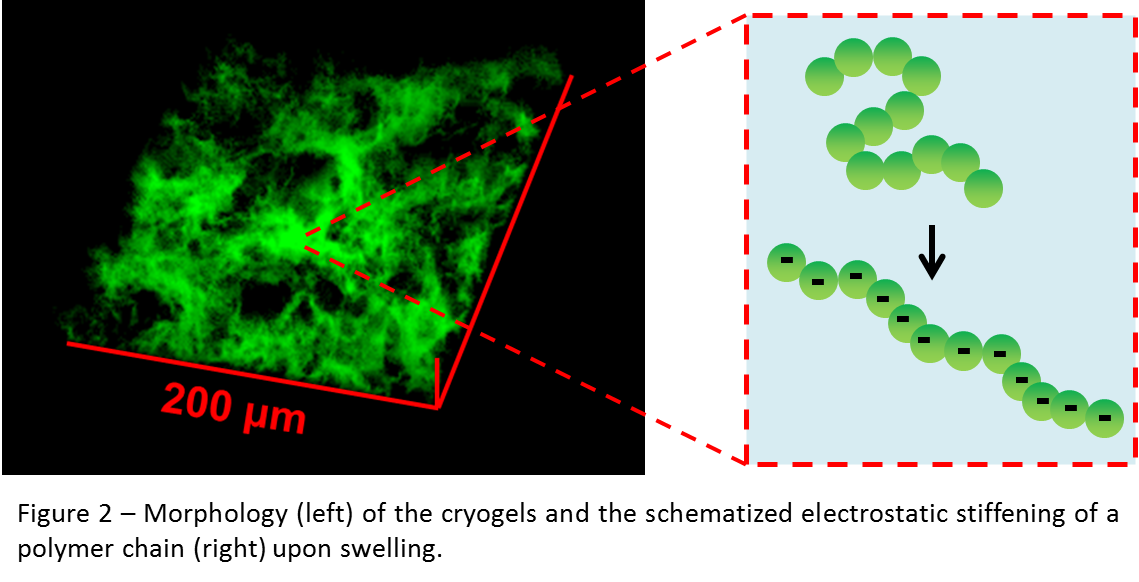Introduction: Cryogels are micro- to macroporous hydrogels where the pore space, filled with fluid, is that occupied by ice crystals during their fabrication at sub-zero temperatures[1]. The large pore size makes them ideal candidates as tissue engineering scaffolds, as it provides room for the accommodation of cells while presenting them with a biocompatible, extracellular matrix-mimicking substrate. Smart cryogels can be made to respond to an external stimulus, such as a change in temperature or pH, by swelling or de-swelling. This is the result of fixed charges on the polymer chains, which pull in counter-ions from the surrounding solution and increase the capacity of the hydrogel to imbibe water. A similar mechanism is observed in cartilage, where the large FCD results in substantial compressive moduli[2].
The mechanics of smart cryogels as a result of swelling is the object of the present study. In particular, the effect of the fixed charge density (FCD) on the modulus of the materials is investigated at the macro- and nanoscale, and compared to that of articular cartilage.
Materials and Methods: Smart, pH-responsive cryogels made from a poly(vinyl alcohol)-poly(acrylic acid) blend were utilized in concentrations varying from 15 % w/w to 25 % w/w. Their morphology as a function of swelling state was observed by confocal microscopy, and the FCD was quantified by nuclear magnetic resonance (NMR) and calculated from first principles. The materials were tested mechanically through multi-scale indentation in a poroelastic framework[3], in order to probe the properties of the gels at the bulk scale, as well as at the scale of single cells. For the latter, the results were compared to those expected from cellular materials mechanics[4]. All results were compared to those for articular cartilage.
Results and Discussion: The compressive modulus of cryogels was found to increase with polymer volume fraction both at the macro- and nanoscale. The relationship between the two scales was found to be well described by cellular materials mechanics, with the macroscale modulus varying linearly with that of the material making up the porous structure.
At the same time, contrary to monolithic gels where the modulus of elasticity is reduced with swelling, the stiffness of cryogels can increase in the swollen state (Figure 1).

This unconventional phenomenon is explained as a result of electrostatic stiffening brought forward by the FCD (Figure 2): it was observed that its effect increases with FCD, and it is made possible by the large concentration of charges in the struts of the microstructure.

In particular, the FCD here was found to vary between 0.10 and 0.23 mEq/g, corresponding to compressive moduli as large as 700 kPa and within the range expected for articular cartilage (FCD: 0.16-0.18 mEq/g).
Conclusions: The results presented picture smart cryogels as cellular scaffolds with enhanced mechanical properties. Their peculiar microstructure allows for a large concentration of fixed charges similar to that found in articular cartilage, and consequently large moduli due to electrostatic stiffening. At the same time, a microporous environment favorable for cell seeding is maintained.
Nano Doctoral Training Centre (NanoDTC); EPSRC; Stoyan K. Smoukov
References:
[1] O. Okay, “Polymeric Cryogels. Advances in Polymer Science.” Springer International Publishing (2014).
[2] V.C. Mow, R. Huiskes, “Basic orthopaedic biomechanics and mechano-biology.” Third edition, LWW (2005).
[3] M.L. Oyen, “Spherical indentation creep following ramp loading.” J Mater Res (2005), 20: 2094.
[4] L.J. Gibson, M.F. Ashby, “Cellular Solids: Structure and Properties.” Second edition, Cambridge University Press (1997).